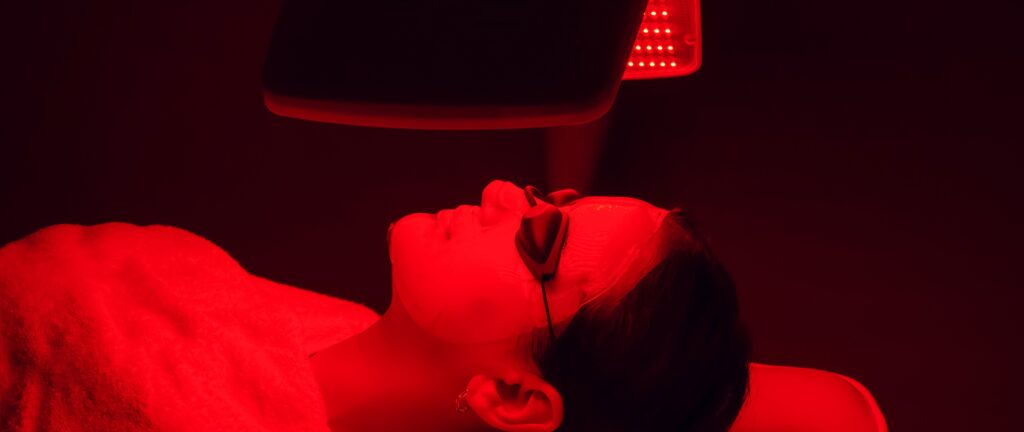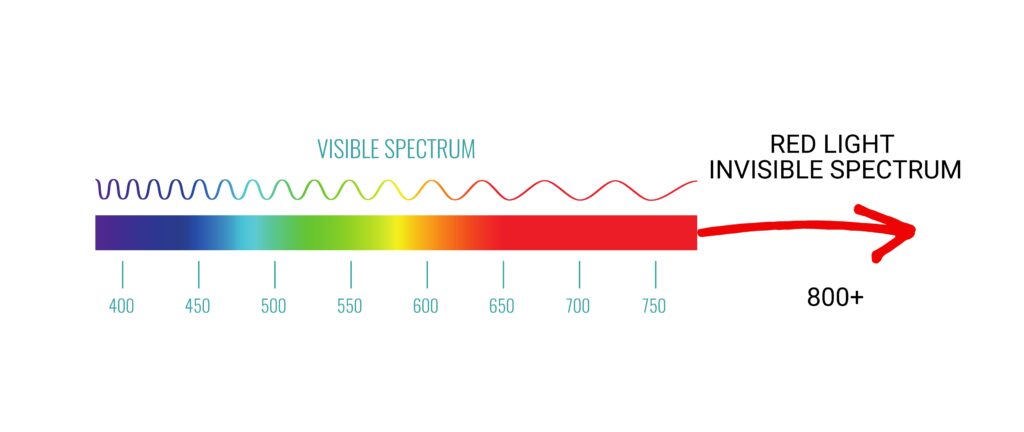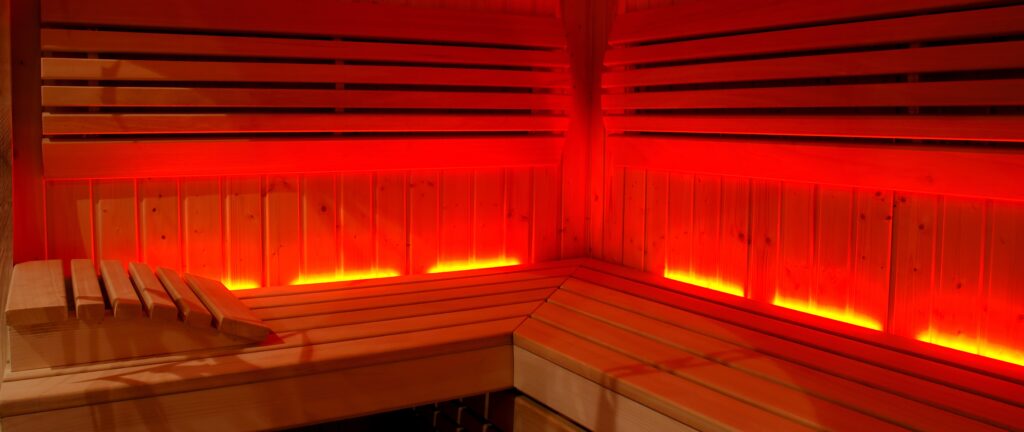We’ve just passed the Winter Solstice, and while the light will be returning and lengthening our daylight hours, we’ve still got a ways to go. Light is such an integral part of our health, and one that we often take for granted. Last week, we discovered how blue light affects us, and this week, we’re exploring another wavelength of our UV spectrum—red light.
Red light therapy is certainly trending these days, and as with any health buzz, it’s a bit tough to discern what’s effective and what is just a costly hobby. In the case of red light, there do appear to be many health benefits including better skin, easing aches and pains, improved wound healing, and of course our favorite—more restful sleep. So let’s get into it!

How Does It Work?
Red light has the ability to penetrate deep into the skin, where the photons are absorbed by our cells—namely the chromophores in our mitochondria. Perhaps you’ve heard our mitochondria being referred to as our “energy powerhouses,” and this is why. They can literally take light as energy from our sun and turn it into energy for our cells. Better cellular energy means more energy overall for a healthy body, and these are some ways we might experience that:
- Less fatigue and better recovery. As you might imagine from the information above, red light contributes to the production of energy via stimulation of ATP in our mitochondria.
- Improved circulation. Blood flow improves because red light therapy aids the release of nitric oxide, allowing cells to receive the oxygen and nutrients they need for optimal function.
- Reduced inflammation. Red light helps regulate inflammatory markers and cytokines, reducing inflammation at a cellular level.
- Better sleep and circadian rhythm management. While too much blue light at the wrong time of day can disrupt our circadian rhythms, red light, especially in the evenings, can help us get in sync by promoting the production of melatonin.
- Mood enhancement. While not fully understood, red light may contribute to the regulation of neurotransmitters like serotonin.

Who Can Benefit?
Just about everybody! Who couldn’t use more energy, better sleep, and smoother skin?! Red light is considered generally safe, but for babies, pregnant women, and anyone with health concerns, it’s always best to ask your doctor.
Red light therapy benefits all sorts of purposes:
- Athletes and fitness enthusiasts. For all the reasons listed above, athletes are fans of red light, particularly for help with muscle soreness and injury recovery.
- Autoimmune conditions. Inflammation and fatigue are two hallmarks of autoimmune conditions, and many are connected to mitochondrial dysfunction.
- Acne. Both blue light and red light therapy has shown to be effective for easing acne—first with blue to help destroy bacteria, and then with red to reduce inflammation.
- Depression and Seasonal Affective Disorder (SAD). While more research is needed, red light therapy appears to ease the symptoms of depression, likely through the anti-inflammatory and neurotransmitter functions. We’ll talk more about SAD in next week’s blog post!
- Cosmetic and anti-aging. Red light stimulates collagen production in the skin, smoothing out fine lines and wrinkles and contributing to a healthier appearance.
- Wound care. Helps speed the healing of burns and post-surgical sutures, and reduces the appearance of scars.
- Eyesight. Red light therapy has been shown to improve age-related vision loss and to help with macular degeneration.
- Shift Workers. These folks have circadian rhythm disruption and tend to get too much blue light. Red light can help them re-regulate their melatonin and cortisol levels.

Seeing Red
Sounds nearly miraculous, right? So how do we incorporate red light into our lives?
First, it’s important to understand the different types of red light therapeutics available. There are three general categories, each with different wavelengths and purposes:
- Red Light Spectrum. 630-660 nanometers. The gentlest of the visible light spectrum used for skin and other surface treatments, widely considered safe with no adverse effects. Recommended for collagen renewal, stimulating hair regrowth, acne, healing skin lesions and wounds, muscle fatigue and soreness, and smoothing out those fine lines and wrinkles.
- Near-Infrared Spectrum. 810-850 nanometers. This range, in the invisible part of the red light spectrum, penetrates deeper than skin into connective tissue, bone, and nerves. Considered mostly safe for use, though eye protection is cautionary. Recommended for neurological health and recovery, depression, accelerated healing and recovery, muscle and joint pain and soreness, and neuropathy.
- Infrared Spectrum. Above 850 nanometers. Most commonly seen in infrared saunas, where the body perceives these waves as heat. People should consult their physician before using if there are any questions or concerns. Shown to be helpful for pain relief, relieving the symptoms of cancer and side effects of chemotherapy, muscle and joint recovery, and neurological healing.
If skin benefits are desired, then a device with red light may be enough, and is generally more affordable than those with higher wavelengths.
The most benefits for the most people will come from a device with both red light and near-infrared light.
For those serious about infrared therapy, in-home devices and saunas are available, or a local facility may have an infrared sauna or bed.
You may also see terms like “low-level light therapy” (LLLT) or photobiomodulation (PBM). LLLT is also used to describe a specific type of red light therapy with lasers—it’s the same idea but delivered differently.

Resources
While UV light is free thanks to our sun, unfortunately, red light therapy devices are not. And while some go through the effort to manufacture up to FDA medical device standards, red light therapy is considered low risk in the general wellness category, so it’s largely unregulated and still buyer beware out there.
Please note that we are not connected to any of these companies, nor do we receive anything for these links, this information is provided freely for your research purposes only.
There are also different devices and solutions for different purposes at different price points:
Free to Low Cost
- For skin and other minor therapies, you may be able to DIY a flashlight, covering it with a red film or filter for the lowest cost option. A red tactical flashlight can also be purchased for this purpose.
- It’s hard to beat free! Get outside for sunrise and/or sunset for 10-15 minutes, when those red wavelengths from the sun are at their peak and the sun’s overall light is at its least harmful to our eyes.
- For better sleep and proper melatonin production, there are many options. You’ll want to be off your screens at least two hours before bed, and you may even want to begin actively blocking blue light when the sun goes down. Check out our resources section from our post on blue light for more.
- Replace bedroom lights with non-blue light lightbulbs. Consider red nightlights and a red reading lamp. BlockBlueLight.com has a wide array of healthy light products.
Show Me the Money
For more specific therapeutic purposes, you’re likely looking at a device.
- In the cosmetic category for skin and hair, there are a multitude of options out there. Do your research and look for well-powered devices.
- Most therapeutic versions come in the form of a panel, and these range from $300 for a small, targeted device all the way up to several thousand dollars for full-body panels with all the bells and whistles. Companies we’ve seen that are frequently recommended are Joovv, Koze, and Platinum Therapy Lights.
General Info
- For the rundown from the popular optimization guru Dr. Andrew Huberman, head over to his podcast for the episode where he covers all things red light therapy.
We hope this has been helpful! For more healthy sleep tips, be sure to follow us on Instagram and Pinterest. Come back next week when we look into Seasonal Affective Disorder (SAD). Until then, sweet dreams!
THIS ARTICLE DOES NOT PROVIDE MEDICAL ADVICE
The information in this article, including but not limited to text, graphics, images, and other materials, are for informational and educational purposes only. No material here is intended as a substitute for professional medical advice, diagnosis, or treatment. Please consult your physician or other qualified health care practitioner with any questions or concerns you may have for your care.

